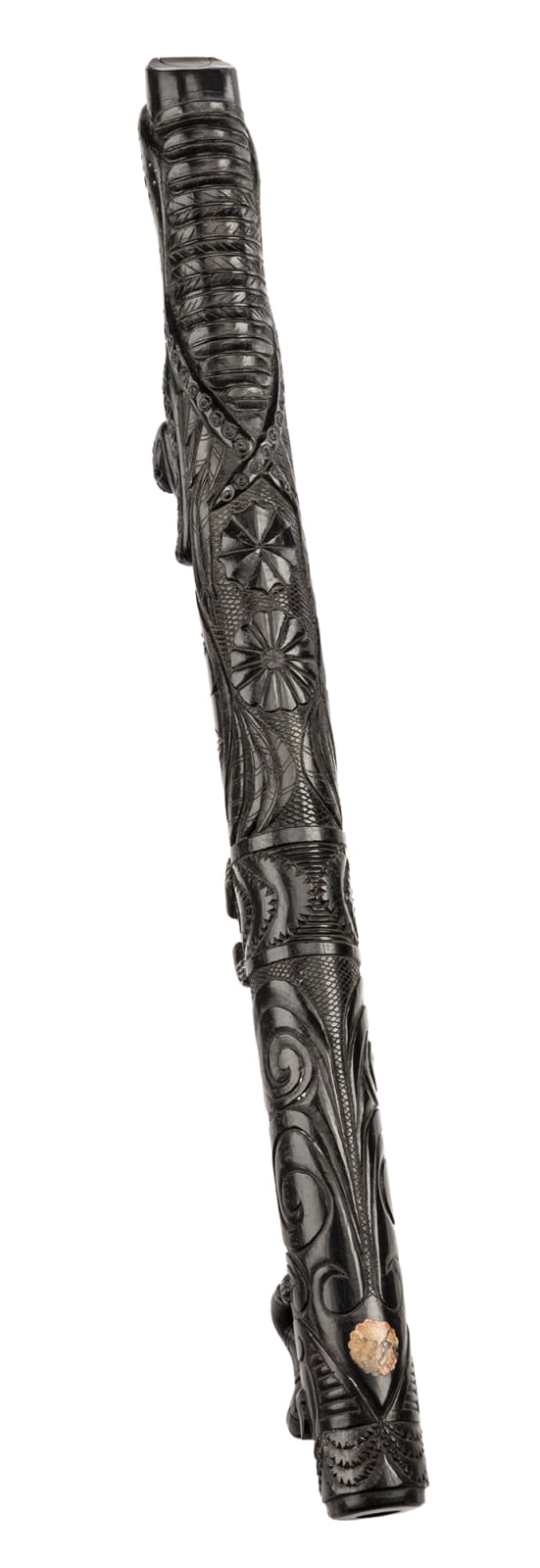-
Artworks
UNIDENTIFIED ARTIST, HAIDA
Recorder (Flute), c. 1845-1865argillite and bone, 2 x 15 x 2 in (5.1 x 38.1 x 5.1 cm)
unsigned;
affixed to the lower rear side is an old rosette-shaped paper label bearing indistinctly inscribed numbers.
LOT 33
ESTIMATE: $25,000 — $35,000
PRICE REALIZED: $33,600.00Further images
Haida recorders are among the most beautiful and elegant argillite works carved by the Haida, and they are also perhaps the rarest, with only some two dozen examples known to...Haida recorders are among the most beautiful and elegant argillite works carved by the Haida, and they are also perhaps the rarest, with only some two dozen examples known to be held in public collections in Canada, the U.S. and Europe. Haida recorders are often called “flutes”; however most are designed to be played vertically and only a very few examples are actually cross-blown transverse instruments. The first documented reference to argillite “flutes” occurs in 1852 (Drew and Wilson 1980:186), and suggests that production was in full swing by then and likely began in the 1840s. The attributes and iconography of the Haida recorder style vary considerably and can include: a supine eagle, often with one or more crouching frogs facing it; usually six (sometimes fewer) finger holes; an inset lead alloy or pewter mouthpiece and foot; metal, ivory, or bone inlay; carved rosettes, tobacco leaves, and other decorative elements.
Even among Haida argillite recorders, this fine example with its highly unusual imagery is very rare. The mouthpiece displays a highly idiosyncratic depiction of an octopus that has captured a hapless human in European garb in its tentacles (rather than the much more typical figure of an eagle, which is usually found at the top end). A second human figure, in a quite acrobatic frog-like supine position, lies at the foot of the recorder; in other words, he stands in for one of the usual frogs. The underside is highly ornamented, featuring unusual grooved and feathered bands at the top (behind the octopus), rosettes and stylized sunburst patterns, as well as tobacco leaves and frond-like leaf shapes. The lovely decorative elements, as well as the European style and clothing of the human figures, suggest a date of production that overlaps with those of Haida ship panel pipes and Western-style tableware.
Special mention should be made of the figure of the octopus and its “victim”: it is a brilliant and quite humorous scene. The octopus has an almost human face, with large eyes, a tiny nose (!), and a roaring mouth that is, of course, the end of the voicing mouth or “window” of the instrument. Its human captive – nicely decked out in a uniform jacket – does not seem the slightest bit perturbed by his predicament. This recorder is one of the finest and absolutely the most charming we have seen.
References: For discussion and illustrations of Haida recorders and/or flutes see Peter L. Macnair and Alan J. Hoover, The Magic Leaves: A History of Haida Argillite Carving (Victoria: Royal BC Museum, 1984/2002), pp. 68-71. See also Leslie Drew and Douglas Wilson, Argillite: Art of the Haida (Vancouver: Hancock House, 1980), pp. 185-187); and see the discussion of argillite “flutes” in Marius Barbeau, Haida Carvers in Argillite (Ottawa: National Museum of Man, 1957/74), pp. 4-8. See illustrations of recorders and flutes in Carol Sheehan, Pipes that won’t Smoke: Coal that won’t Burn: Haida Sculpture in Argillite (Calgary: Glenbow Museum, 1981), p. 133 and cats. 46-49; the imagery in the flute (cat. 46) includes an octopus and eagle clasping each other. For an interesting example with a serpent or dragon see Thomas Vaughan and Bill Holm, Soft Gold: The Fur Trade & Cultural Exchange on the Northwest Coast of America, fig. 115. For fine examples at auction see Walker’s Auctions, Ottawa, May 2017, Lot 55; and Sotheby’s, NY, May 27, 1987, Lot 227.
Provenance
Private Collection, California;
A New York Collection.
Join our mailing list
* denotes required fields
We will process the personal data you have supplied in accordance with our privacy policy (available on request). You can unsubscribe or change your preferences at any time by clicking the link in our emails.








